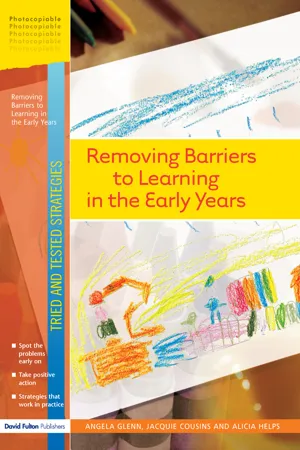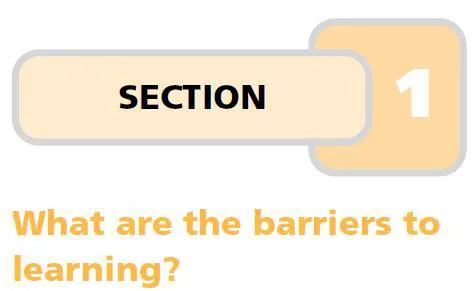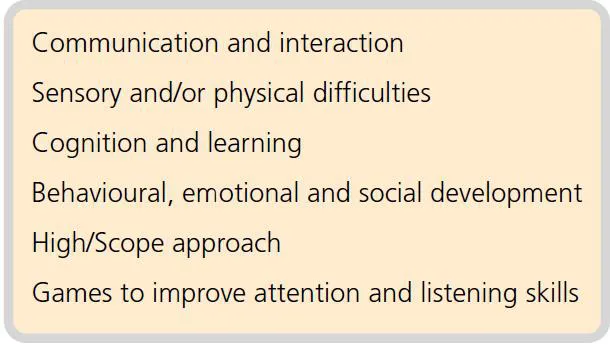
eBook - ePub
Removing Barriers to Learning in the Early Years
This is a test
- 104 pages
- English
- ePUB (mobile friendly)
- Available on iOS & Android
eBook - ePub
Removing Barriers to Learning in the Early Years
Book details
Book preview
Table of contents
Citations
About This Book
This book shows how different types of SEN can impact on a child's learning and what practitioners can do to help. Includes:
- photocopiable record sheets
- helpful explanations of responsibilities in relation to the Code of Practice and SENDA
- short case studies that illustrate how strategies work in practice.
Frequently asked questions
At the moment all of our mobile-responsive ePub books are available to download via the app. Most of our PDFs are also available to download and we're working on making the final remaining ones downloadable now. Learn more here.
Both plans give you full access to the library and all of Perlego’s features. The only differences are the price and subscription period: With the annual plan you’ll save around 30% compared to 12 months on the monthly plan.
We are an online textbook subscription service, where you can get access to an entire online library for less than the price of a single book per month. With over 1 million books across 1000+ topics, we’ve got you covered! Learn more here.
Look out for the read-aloud symbol on your next book to see if you can listen to it. The read-aloud tool reads text aloud for you, highlighting the text as it is being read. You can pause it, speed it up and slow it down. Learn more here.
Yes, you can access Removing Barriers to Learning in the Early Years by Angela Glenn,Jaquie Cousins,Alicia Helps in PDF and/or ePUB format, as well as other popular books in Education & Education General. We have over one million books available in our catalogue for you to explore.
Information


All young children are born with a sense of curiosity about the world in which they live. Through learning, children develop essential survival skills and organise their world so as to make sense of it. They learn to acquire crucial ‘building block’ skills and also to regulate their environment which in turn helps them to live in a social world. For many, however, there are circumstances which can impede learning – especially if adults around the child fail to understand the difficulties he is experiencing and/or are unsure about how to take positive action.
Communication and interaction
‘No man is an island’ and children learn about themselves and the world through their interaction with others. Various theories have been put forward about this learning, including the importance of language, a staged ‘readiness’ approach and the importance of attachment between a parent and child. For children who have difficulties with understanding and using language, early years settings can be terrifying places! Imagine being left in unfamiliar surroundings with people speaking in a way you didn’t understand. If you suspect that a child is experiencing this sort of difficulty, you need to consider the following course of action:
- Speak to parents/carers and find out what the child is like at home. What do they find works with him?

- Get advice from the Area SENCO and/or a speech and language therapist

- Speak slowly and clearly and support what you say with facial expression and gesture – a picture communication system may prove useful. (See PECS reference at the back of the book)

- Make eye contact with the child

- Be very specific when giving instructions; instead of saying ‘Let’s get ready for playtime’, explain exactly what needs to be done: ‘Let’s put away the bricks now and put on our coats to go outside for playtime.’

- Make sure there is no hearing impairment – many children experience temporary loss of hearing through ‘glue ear’

- If a child has autistic tendencies, there will be situations he finds difficult to deal with, for example lots of noise and running about; you need to be aware of this and find out how to manage it. A key worker will need to support the child and be sensitive to his needs

Sensory and/or physical difficulties
These sorts of difficulties are often the most straightforward to cater for and will usually have been identified by the health visitor/GP/parents. There may or may not be additional learning difficulties to take into account. Where the child has no additional problems, it is important not to allow the impairment in moving, hearing or seeing to limit the child’s learning. This has a lot to do with expectations and encouraging the child to be as independent as possible. Wrapping him in cotton wool and doing everything for him will not be the best preparation for coping with the school environment later on. The other children also need to understand this.
In some instances, parents may not be aware of a sight or hearing impairment and it is only when in the early years setting that the child begins to experience difficulties. For example, parents may be used to speaking loudly and so the child with a hearing impairment does not struggle to hear them. At pre-school, with staff who have softer voices, and the added dimension of extra background noise, the child has much more difficulty. Look out for the child who:
- Does not follow instructions correctly

- Concentrates intently on the faces of people talking

- Copies other children

- Does not react to sudden noises

- Does not join in with rhymes and songs

- Talks too loudly

- Has delayed or indistinct speech

- Tilts his head when listening to a story

- Appears to be in a world of his own

- Has a discharge from his ear

A visual impairment may be noticed only when a child begins to learn to read and finds that the print is blurry. Look out for the child who:
- Holds books and objects close to his face

- Bangs into people and things, trips over objects

- Always sits at the front for stories or television

- Has difficulty with activities such as threading, which require good hand/eye co-ordination

- Has unusual eye movements

- Rubs his eyes a lot

- Holds his head in an unusual position

A child with physical/motor difficulties may:
- Seem to be very clumsy

- Have poor balance

- Have poor gross motor skills – find it hard to ride a trike, climb up the steps of a slide, kick a ball

- Have difficulty with fine motor skills such as threading, cutting out, drawing, fastening buttons

In these cases, parents should be encouraged to take the child to his GP who may arrange for a thorough examination by a specialist.
Once a child’s difficulties have been identified, there is much that can be done to minimise the difficulties (see the ‘Top tips’ section on pp. 67–78) and a consideration of the setting’s environment is a good starting point.
Looking at the physical environment:
- Find out if the child needs any special furniture or equipment – this can sometimes be borrowed from a resource base in the authority

- Have tables and chairs of different heights

- Ma...

Table of contents
- Front Cover
- Title
- Copyright
- Contents
- Acknowledgements
- Introduction
- Section 1 What are the barriers to learning?
- Section 2 Case studies
- Section 3 Planning
- Section 4 Top tips for teaching and learning
- Appendix 1 Recording pack
- Appendix 2 Developmental checklists
- Glossary
- References
- Further reading
- Useful addresses